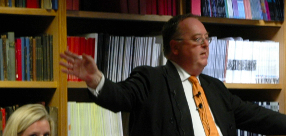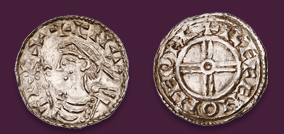Auction: 25007 - … British and World Coins and Medals featuring The Oriole Collection of Gold and Silver English Coins
Lot: 438
PCGS SP61 | Edward VIII (20 January - 11 December 1936), Rugby School (Sovereign's Prize: The Dr Thomas Arnold Award for Modern History), His Majesty The King's Gold Medal, 1936, awarded to Captain Patrick Findlater Stewart MC, SSM, late 11th Hussars (Royal Armoured Corps), by Thomas Humphrey Paget and Leonard Charles Wyon for Sir Robert Arthur Johnson, Deputy Master and Comptroller of the Royal Mint (London), EDWARDVS VIII D. G. BR: OMN: REX F. D. IND: IMP. 'classical' coin legend and bare head left, rev. HISTORIAE RECENTIORIS STUDIUM APUD SCHOLAM RUGBEIENSEM ARNOLDO AUCTORE INSTITUTUM PRAEMIO FOVET MUNIFICENTIA REGIS in nine lines, edge plain but for Official Hallmark at 12 o'clock [RJ | London | A | Crown | 18] and Officially Mint-Engraved in New Roman capitalised script: PATRICK. F. STEWART, 1936. at 6 o'clock, 57.56g, 45mm., 12h (Giordano CM 157; Jeremy Cheek, 'Royal Prize Medals', [BNJ 2018], pp. 177-188, no. 20), light fingermarks in otherwise brilliant fields, as struck, UNIQUE; AND OF NATIONAL SIGNIFICANCE, one of very few Sovereign Prize Medals bestowed by the Duke of Windsor during his infamous 325-day reign as King Edward VIII still available to the private collector, accompanied by the Official Royal Mint maroon case of issue, bearing the rare Gilt Block cypher EVIIIR, in PCGS holder, graded SPECIMEN 61 (Cert. #55968554)
Provenance
Sold by Order of the Direct Descendant
As Cheek notes: "Laurence Brown went to great lengths to define which medals should or should not be included in his book. Generally prize medals were excluded, as he felt that if he did not do so the book would never be complete or be published. However his overriding consideration was that medals of national importance would be included. As Royal Prize Medals were thought to be of national importance they were there confusingly in both categories. The result was that Royal Prize Medals issued during the reigns of George IV (1820-1830) to George VI (1936-1952) were included in BHM...."
He continues: "There are also other Royal Price Medals not listed in BHM and not present in the following set: those medals produced with the effigy of Edward VIII, of which twenty-six were produced late in 1937. Equivalent issues to nos. 1-7, 10-12, 14-16, 18 and 20-21 were produced bearing the effigy of Edward VIII; no Edward VIII medals were produced for the Royal Geographical Society (Founder's Medal); the Royal Institute of British Architects, the Police Essay Competition or the Poetry Medal. A Royal Household Long and Faithful Service medal of Edward VIII was produced but never awarded; there is an example in the Royal Mint Museum.
Laurence Brown was an assiduous researcher and I am sure that the omission of these medals from BHM was deliberate, presumably because he believed that they should be considered as Patterns for medals that were not issued, and thus lay outside the scope of his book. However since the publication of BHM two examples of Royal Prize Medals with the effigy of Edward VIII have appeared at auction inscribed with recipients' names, so it would appear that at least two were in fact awarded. There are no specimens of Royal Prize Medals with the effigy of Edward VIII in the Royal Collection."
Corpus:
1. Royal Military Academy (Woolwich) (1 AV); Awarded to Hugh Acton Jefferies, July 1936. Late Captain, Royal Irish Fusiliers. Killed in Action, 19 May 1940 at Dunkirk. Medal and Sword of Honour on display at Royal Irish Fusiliers Museum.
2. Britannia Royal Naval College (Dartmouth) (1 AV); Awarded to Peter Sumner Wilson; Morton & Eden, Auction 8, 25 May 2004, lot 133; Private Collection.
3. Royal Air Force College (Cranwell) (1 AV); Awarded to Douglas Andrew Kerr, July 1936. Late Wing Commander, 148 Squadron. Killed in Action, 22 June 1942 at Gazala, near Benghazi (Libya).
4. King's Lynn Grammar (King Edward VII School, Norfolk) (1 AV); Awarded to Ronald Neville Aldrich-Smith, October 1936.
5. Royal Victoria College, Jersey (3 AV); Prizes for Classics, Modern Languages and Mathematics.
6. Nautical College (Pangbourne) (1 AV); Awarded to George Lainchbury Bown; DNW Auction, 7-8 September 2021, lot 1397; Purchased by Chairman Phillip Plato (Old Pangbournian Society). Loaned to Pangbourne College, 28 October 2021.
7. Royal Naval Australian College (Creswell) (1 AV).
8. Royal Geographical Society (London). Founder's Medal. Not awarded in 1936.
9. Royal Institute of British Architects. Not awarded in 1936.
10. Royal Geographical Society (London) (1 AV); Patron's Medal.
11. Thames Nautical College (H.M.S Worcester) (1 AV); Awarded to Kenneth Hodson; Sotheby’s, 5 July 1994, lot 211; Private Collection.
12. Royal Military College of Australia (Duntroon, Canberra) (1 AV).
13. Police Essay Competition. Not awarded in 1936.
14. Royal Society (2 AV, 1 AR); Newton Medal.
15. Winchester College (2 AV; 2 AR); Prizes for Latin and English Verse.
i) Awarded to Christopher Ivan William Seton-Watson; Spink, NYINC Sale 392, 14 January 2024, lot 204. Private Collection.
16. Merchant Navy Cadet School (H.M.S Conway) (1 AV); Awarded to Richard Ewart Hutson, July 1936. Held by the Liverpool Maritime Museum.
17. Royal Australian Air Force College (Point Cook). Not awarded in 1936.
18. Wellington College (Sandhurst) (1 AV).
19. King's Medal for Poetry. Not awarded in 1936.
20. Rugby School (1 AV); History Prize. Awarded to Patrick Findlater Stewart. This Medal.
21. South African Nautical College (General Botha) (1 AV).
22. Junior Nautical Schools. Not awarded in 1936.
23. Long and Faithful Service (Royal Household). Designed, but never awarded. A pattern in Silver exists in the Royal Mint Museum.
24. Shipwrights Company. Not awarded in 1936.
The abdication of King Edward VIII on the 11 December 1936 brought to an end a tumultuous 325-day reign. The termination of his reign brought with it the logistical headache of scrapping his approved effigy for a replacement in the likeness of King George VI. Deputy-Master of the Royal Mint (1922-1938), Sir Robert Arthur Johnson conceded: "The work of the two artists was all but completed when the events of last December rendered it nugatory. Over 200 dies of coins, medals and seals were thus rendered useless and the Mint was faced with the task of securing portraits of his present Majesty with but limited time available." He added in the same December 1937 interview shortly before his death: "I am betraying no profound secret in stating that the coinage effigy of the former King was, at his personal wish, prepared facing to the left. But as there has been no coinage bearing the bust of the former King, the old tradition has maintained by showing the effigy of the present monarch facing in the same direction as the last monarch but one. The new King's effigy faces left, as did those of King George V and Queen Victoria, a fact which is surely one of the most happy augury."
He concluded: "During 1936, in the early stages when the coinage for King Edward was in question, I was made aware that some desire existed for a complete departure from the heraldic tradition which has been associated for several centuries with our principal coins."
Based on surviving Royal Mint Archives, Official Gazette entries, contemporary newspaper reports and eyewitness accounts, the following timeline can be reconstructed for the numismatic and philatelic record of the short-lived King's reign.
20 January 1936 - At five minutes to midnight, King George V dies at Sandringham and his eldest son David, Prince of Wales becomes King Edward VIII.
Thursday, 6 February 1936 - An official at the General Post Office informs the Daily Telegraph, that: "New postage stamps and postal orders bearing the portrait of King Edward VIII are not likely to be issued until the end of the year. It can also be authoritatively stated that no mourning stamps are to be printed. The annual sale of stamps in Britain totals 7,000,000,000. Postal orders number 225,000,000. Of the 70,000 letter boxes in the country, comparatively few will bear King Edward's initials for some time. New boxes will do so. Letter boxes bearing the inscription E.R. VII are still in existence, and there are still a few old ones marked V.R. On the 9,000 mail vans, the Royal initials will be altered as the vehicles are repainted." It is estimated that only 271 post-boxes bearing the cypher of Edward VIII were eventually produced.
Friday, 21 February 1936 - "The King received Sir Robert Johnson, Deputy Master of the Royal Mint at Buckingham Palace, and inspected a plaster cast of his own head, which had been prepared at the Mint. The cast will, with Royal Approval, be used not only for the new coins, but also in the preparation of dies for medals and other purposes."
Friday, 13 March 1936 - "The King has approved two designs for the new Royal cypher: "E.R. VIII.". The War Office will make known to the public next week the designs submitted by Garter King of Arms which have been approved by the King. One Cypher in plain modern block letters surmounted by the Imperial Crown, will be used by the postal authorities and Government offices, Embassies, Legations and Consulates abroad, and by Dominions, India and the Crown Colonies. The other cypher follows the traditional style of interlocked initials with oak-leaf fringes. This will be used by the armed forces and the constabulary of the Empire."
Tuesday, 28 April 1936 - The King sat at Buckingham Palace for the two medallionists [Thomas Humphrey Paget and Percy Metcalfe] of the Royal Mint, for the head which will appear on the new coinage and the medals which will be granted by King Edward the Eighth.
Friday, 1 May 1936 - In what is estimated to be a £1,000,000 stimulus to the manufacturing and stationery industry of Britain, the first printed examples of the King's Cypher appear in circulation.
Saturday, 30 May 1936 - Bradford Post Office becomes the first building in Britain to feature the King's new cypher.
Monday, 20 July 1936 - The Annual Swan Voyage of His Swan Master's Skiff along the River Thames exhibits the new Royal Cypher 'in red surmounted by a gold crown'.
Friday 31 July 1936 - Sir William Currie, Chairman of the Worcester Committee announced that the King had been graciously pleased to become the patron of [Thames Nautical College, H.M.S.] Worcester. The King's gold medal was won by Kenneth Hodson. "A letter from the Secretary of the King's Privy Purse was read explaining that the medal could not be presented yet as a new one had to be cast bearing King Edward's head." This same medal was later sold by Sotheby's on 5 July 1994 (lot 211) and is believed to remain in a Private Collection.
Friday, 7 August 1936 - The King approves the uncrowned effigy submitted by Mr Thomas Humphrey Paget for his coins and medals, and the designs for the reverse of the new silver coinage by Mr George Kruger Gray.
Tuesday, 1 September 1936 - Edward VIII's uncrowned effigy is released on stamps at midnight, featuring the series of halfpenny, threehalfpenny and twopence-halfpenny. London's three 'all-night post offices' in Fleet Street were besieged by collectors with queues forming two hours beforehand. "The issue was regarded as the greatest success of any recorded by the Post Office as over 30,000,000 stamps were sold on the first day." The following day however, critics were quick to note: "The head of the King is far from being the best photograph that has ever been taken and makes him appear more youthful than he really is. People are asking why there could not have been a break from tradition. Why always a face in profile? Why not full face, with the King wearing that boyish smile which has endeared him to millions? The new Australian stamp shows the King full face, so why not the English?" The Belfast Newsletter notes: "People are expressing the hope that a little more imagination will be displayed in the preparation of the new King Edward coins than has been manifested in the printing of the new stamps."
Monday, 14 September 1936 - The penny stamp of Edward VIII is released.
Wednesday, 16 September 1936 - The Royal Mint submits proposals to the Treasury for a new larger Threepence coin. An official stated: "the size is midway between that of a sixpence and a shilling. Efforts are being made to find a distinctive edge for the coin. The metal to be used has not yet been decided upon. The new coin will not however be made of silver or nickel." As Prince of Wales, Edward had described the silver issue, colloquially dubbed a 'joey' as an 'annoying coin'.
Monday, 8 December 1936 - The Official Gazette, Notice No. 769 states: His Majesty the King has approved the issue of the customary official medal to commemorate His Majesty's Coronation. The medal will show on the obverse the crowned effigy of His Majesty with legend, and on the reverse the gateway of St James's Palace. "The Royal Mint are prepared to accept orders for these medals in Gold, large size, diameter 2.5 inches, price 50 guineas; small size, diameter 1.25 inches, price 12 guineas." Notice No. 770, states: "It has been announced that His Majesty the King will broadcast a message to the Empire on the day of his Coronation, Wednesday 12 May 1937. This will be His Majesty's first act after the Coronation ceremony is over. It is understood that a message to the Empire will not be broadcast by His Majesty at Christmas."
Wednesday, 10 December 1936 - King Edward VIII signs his 'Instrument of Abdication'
Thursday, 11 December 1936 - King George VI accedes to the throne
Tuesday, 2 March 1937 - The Royal Mint produces the obverse die hub for the Winchester College, King's Prize Medal. As each Royal Award is the preserve of the incumbent Sovereign, it is elected to retrospectively strike the medals with the 'classical' uncrowned effigy of the former King Edward VIII for those awarded in 1936. These are distributed to recipients over the following month.
i) The Royal Collection boasts the artist's approval in gilt metal of King George VI sent for the monarch's personal assent (RCIN 443736). No artistic trials of Edward VIII were produced for the same purpose as the medals were to be produced retrospectively.
https://www.pcgs.com/cert/55968554
Subject to 20% VAT on Buyer’s Premium. For more information please view Terms and Conditions for Buyers.
Estimate
£14,000 to £20,000
Starting price
£10000













